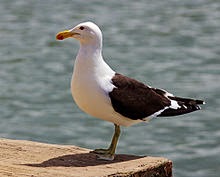If you are interested in birding, this is the place to visit. The region hosts 198 known species which can be classified into 44 families. 116 of these species build their nests and stay in the region throughout the year. and the balance are migrating species. They are regular visitors during the summer and winter each year. Both nesting and regular visitors are characteristic of the region. Listed below are some of the birds and classified as either sea, land and shore birds.
Seabirds.
The Wandering Albatross is the world's largest bird. When flying it's wingspan can go up to 13 feet. It nests in the islands off South America. These seabirds have long and narrow wings and a short tail. The beak is long and robust, with independent nasal tubes located on either side of the upper jaw. It's characteristically soaring flight allows them to cover great distances without flapping their wings. They are permanently on the lookout for planktonic food, crustaceans and fish. A wandering albatross' distinguishing trait is its black tail.
 |
| The Wandering Albatross |
 |
| Kelp Gull |
 | |
| Southern Giant Petrel |
Shorebirds
The Magellanic Penguin is the most characteristic penguin in the Magellan region and Tierra del Fuego. During the wintertime it migrates northwards in search of more temperate waters. In September the first males return to the region to prepare the nest for females who arrive a week later. Upon finding each other, breeding season ensues and three months later, towards the end of December, the chicks are born. For the following three months, chicks learn how to survive while feeding on what their parents regurgitate. Then, from March onwards, they migrate northwards together with the adults. It has been discovered that adults accompany the juvenile during the initial sea-bound phase, and then come back to shed their plumage.
The Rock Shag or cormorant is an aquatic bird and an excellent diver. They taxi on the surface of the water before taking off. After diving they are quite heavy, as their feathers are not 100% waterproof. These birds stretch their necks while flying and they have a very horizontal flight. This cormorant can be identified through its completely black neck and head. They mostly feed on fish and nest in rock ledges. They are particularly visible at the Tucker Islands. They produce rich guano, which is usually used as fertilizer.
The Kelp Goose has a very clear sexual dimorphism. The male is mostly white and the female is almost entirely black, with some white feathers on the wings. When the female dies, the male will remain by her body for a long time. When the male dies, on the other hand, the female female flies away immediately thereafter. (Go figure) This is a very common resident species. It only lives on the seashore or by inland seawater pockets. It feeds on seaweeds.
The Fuegian Steamer Duck is mostly steel-gray, with a white belly, orange beak and yellow feet. It is big, sturdy and incapable of flying. It can usually be seen moving along the water at a considerable speed, paddling along like a steamer boat. They are very good divers and feed on crustaceans and mollusks.
Land birds
The Upland Goose is a very common geese species in Patagonia. We saw them everywhere we went, usually in pairs, but never in flocks. Sexual dimorphism is strong. The males features a white head and neck while the female is grayish brown. The male upland goose uses white to attract attention of predators and the protects the female and juveniles. (I wonder who protects him).
 |
| Upland Goose |
Click on the banner for great buys from Bass Pro.

.jpg)




.jpg)
No comments:
Post a Comment